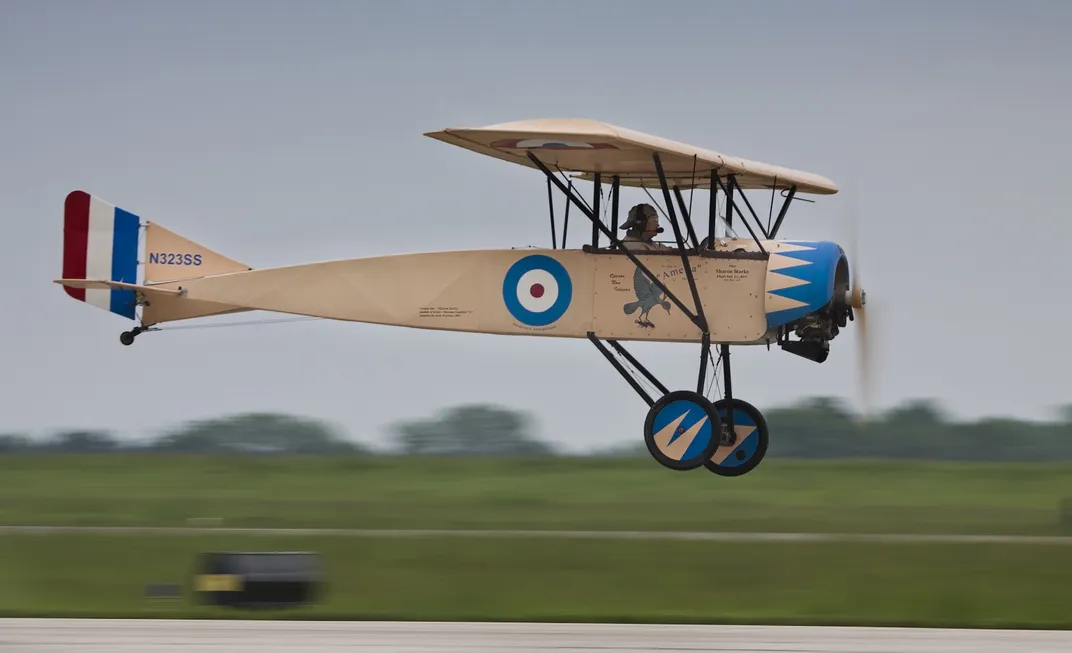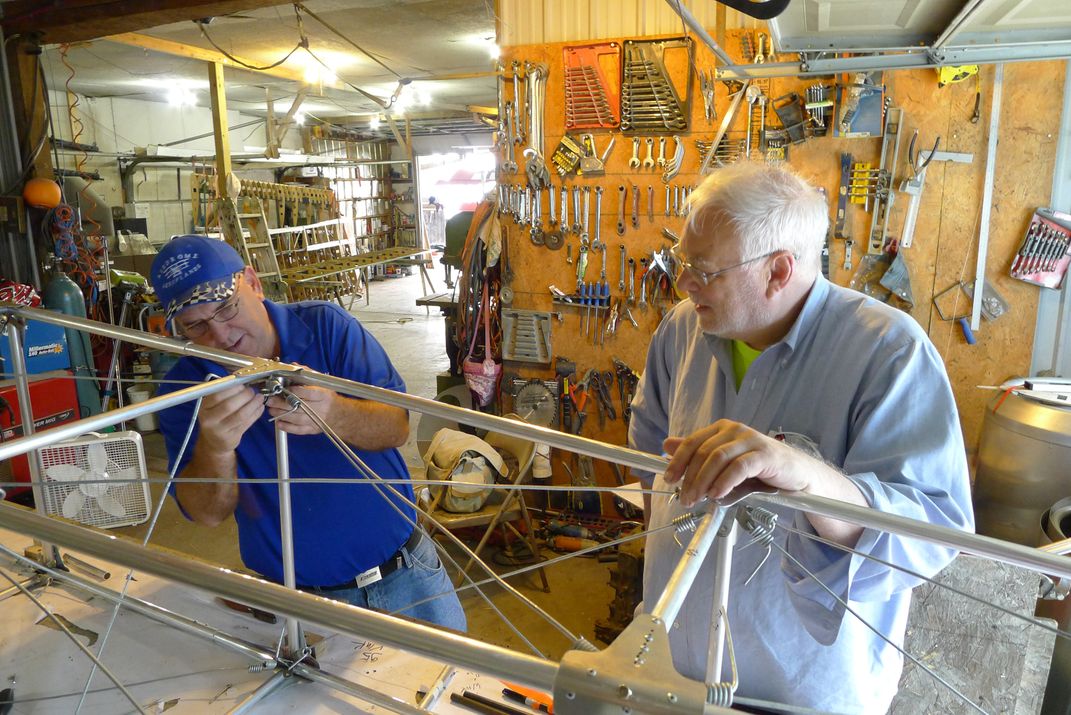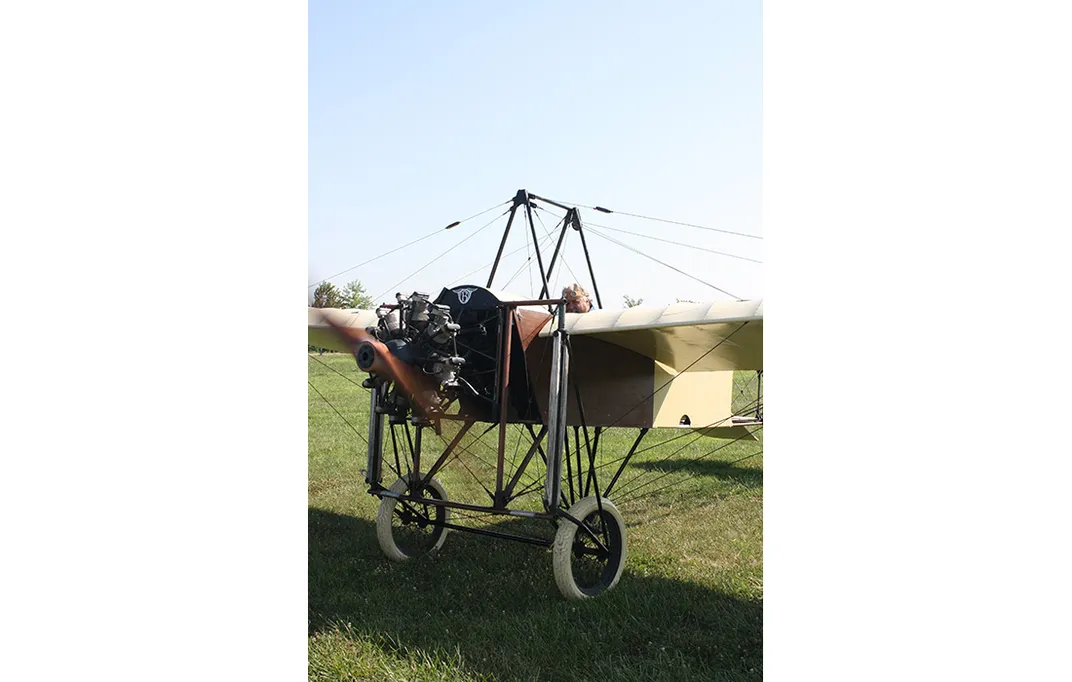Where to Buy a WWI Aeroplane
Just like the ones they used to fly in 1917—almost.
:focal(1703x2024:1704x2025)/https://tf-cmsv2-smithsonianmag-media.s3.amazonaws.com/filer/30/e9/30e99694-3391-4728-933e-11fb2c659dcc/34e_aug14_img_2952_live.jpg)
Robert Baslee doesn’t get any walk-in traffic. Nor does he get any drive-by traffic. Or even fly-in traffic, despite the grass airstrip at his shop. But working mostly by himself in a remote outpost an hour east of Kansas City, Missouri, accessible only by a gravel road that crunches past cornfields and a gun club, Baslee is the king of the Great War aircraft-lookalike industry.
Flyable World War I airplanes come in three levels of accuracy. The most authentic are the original airplanes, which are exceedingly rare and valuable almost beyond measure. Javier Arango’s Aeroplane Collection in California, for example (see “Perfect Specimens,” Feb./Mar. 2013), includes two originals, a 1917 Sopwith Camel and a 1911 Blériot. Next in stature are reproductions, which are painstakingly built out of wood to mimic not only the dimensions but also the construction philosophy and flight characteristics of the real things. (Such a level is represented by the other 21 aircraft in the Aeroplane Collection. Arango’s goal is to experience what it was like to fly these airplanes a century ago.) Most common and least expensive are replicas, like Baslee’s, fabricated from metal and designed to evoke the lore and re-create the shape but not the flying qualities of the originals.
Altogether, there can’t be more than 150 flyable World War I-type airplanes in the world. Baslee has built more than 30 of them, and customers have assembled another 50 or 60 from his kits. “It’s not a huge market,” he says, grinning affably as he rivets a pair of aluminum tubes into a wing rib for a 7/8th-scale Fokker Triplane he’s building in a shop barely large enough to accommodate it. “But I created it, I developed it, and now I own it.”
Baslee, a stout 49-year-old, is the perfect man for the role—an obsessive aviation geek and master machinist who spent a decade working as a mechanical engineer. He grew up a few miles from his shop in rural Missouri with an interest in old airplanes and an affinity for tinkering. As a kid, he rode his bicycle 12 miles to an airport just to gawk, and he started building a Rand KR-2 from plans when he was 15. He soloed on his 16th birthday and earned his pilot’s license shortly after turning 17.
Baslee then embarked on a series of homebuilts—a VariEze, a Long-EZ, a Glasair, which he built with a partner—financing each new project by selling the old one. In 1988, he was struck by a crazy thought: Man, I’d like to build a triplane. Working from photos in his one-car garage, he fashioned a full-scale airplane that looked remarkably like the Fokker Dr.1 flown by Manfred von Richthofen. He then hitched it to a VW Rabbit and towed it to Oshkosh, Wisconsin.
Baslee’s bright-red airplane was a hit at the Experimental Aircraft Association’s annual aviation bacchanal.
“Where’d you get that kit?” wide-eyed spectators asked.
“It’s not a kit,” he told them. “I built it myself.”
“Well,” they said, “when are you going to start offering one?”
Baslee went home and created Airdrome Aeroplanes. The next year, while continuing to hold down a full-time job as an engineer in the photo lab industry, he made his first sale: a kit for a three-quarter-scale Fokker D.VIII. It wasn’t until 1996 that he felt confident enough to buy property that could accommodate a purpose-built shop and private airfield. In 1999, he finally quit his day gig and devoted his professional life to World War I replicas.
The Airdrome Aeroplanes shop is a sprawling space that’s crammed floor to ceiling with stuff—a wing here, rolls of cable there. Baslee owns an impressive array of gear—everything from a computer-controlled plasma cutter to lathes that are older than he is—and he makes just about everything he needs in-house. But the secret of his success is his ability to reduce the complexity of a buildable kit.
Case in point: Baslee creates the French curve of the wing rib by bending aluminum tubes in a rudimentary but accurate fixture that he fashioned from plywood 20 years ago. As we talk, he assembles wing ribs for the Triplane, riveting a curved upper piece of 6061-T6 aluminum to a straight lower tube so that the notches for the scalloped trailing edges line up perfectly. If he’d been working in wood, each rib would have taken a full day of meticulous labor to shape properly. Baslee knocks out two dozen metal ones in less than an hour, as systematically as a robot working on an assembly line. “It’s all about the process,” he says without pausing. “I’m very good at making things simple to do and easy to repeat, repeat, repeat, repeat.”
Airdrome Aeroplanes offers kits for 25 airplanes, ranging from a Blériot XI—the first airplane to cross the English Channel—to a Sopwith Camel fighter similar to the one that shot down the Red Baron. All of them share the same basic fuselage, wing structure, and flight controls. Aside from obvious cosmetic discrepancies, the major differences between them are the dimensions. “They’re like Erector sets,” Baslee says.
Although he originally focused on three-quarter-scale kits, Baslee moved to full-size airplanes as the available engines—and pilots—grew. Almost all of his models fly under the Federal Aviation Administration’s Light-Sport Aircraft regulations. (The rest are considered ultra-lights.) Even the full-size replicas are substantially lighter than the originals. But fitted with modified Volkswagen engines, two-stroke Rotaxes, or Australian-built Rotec radials, the lookalikes benefit from power-to-weight ratios close to those of actual World War I aircraft. “They’re not about going fast,” Baslee says. “They’re not about being efficient. They’re not about going someplace. You fly them because you want the experience of flying old airplanes.”
Depending on the airplane, top speed is usually around 100 mph, and performance is similar to small tail-draggers, like an Aeronca Champ. “With pretty much everything he builds, you can just open the throttle, pull back on the stick, and start flying,” says Harvey Cleveland, who test-flies all of Baslee’s prototypes. Customers are equally complimentary. Sharon Starks built a Morane-Saulnier L with her husband, Dick, from an Airdrome Aeroplanes kit, and says: “She flies like a little ballerina.”
Although Baslee is passionate about his airplanes, his simple, highly structured, and easily repeatable construction techniques are designed to make his company a money-making proposition, not a labor of love. His kits sell from $3,500 (Dream Classic, inspired by the 1908 Santos-Dumont Demoiselle) to $15,000 (Sopwith Tabloid), not including the engine, and to date he’s sold more than 400 to customers in a dozen countries. He offers turnkey airplanes for $90,000 a pop, and he’s built airplanes for the movies Flyboys, Amelia, and the upcoming The Uberkanone. He’s also taken on one-off projects such as a Spirit of St. Louis created for a TV commercial for a St. Louis bank.
Most of his customers are airline pilots and ex-military aviators—“I once had seven colonels in here at the same time,” Baslee says—so he rarely deals with blank-slate newcomers. Still, he insists that building one of his kits requires no special skills, such as welding. “You could take delivery on the back of a pickup truck, take it out to a cabin in the woods with no electricity, and put an airplane together with a vise, a portable drill, a file, basic wrenches, and a hammer,” he says. “I’ve done everything else.”
Retired Air Force Colonel Blake Thomas, who’d flown F-15s in combat, wanted a Nieuport 28 because that was the fighter his squadron had flown during World War I. “All the old guys I talked to told me, ‘Don’t build the original airplane because it was a POS,’ ” he says, explaining why he instead chose to build an Airdrome Aeroplanes kit that he accessorized with luxuries like cabin heat and GPS. “I wanted something that flew like a modern airplane and didn’t break down every two hours.”
To ensure his airplanes are safe and reliable, Baslee readily deviates from original specs, producing a more forgiving airfoil or a beefier metal structure, relocating the landing gear to adjust the center of gravity, and substituting rip-stop nylon for doped fabric. He also adds brakes, steerable tailwheels, and modern flight controls. (The Blériot was an exception. “I now know why we don’t use wing warping anymore,” he says.)
Each kit incorporates about 4,000 pieces, from tubes to bolts to gussets. The kits are divided into 12 sub-kits, and the pieces are numbered sequentially. Thus, R1 is the first piece in the rudder assembly, L6 is the sixth piece in the landing gear assembly and WG2 is the second gusset in the wing assembly. The kit comes with a DVD that shows the build and gives detailed instructions that begin: “Choose your workspace wisely. If you build [the aircraft] in a basement, just be sure you have a window or door large enough to get the assembled parts out!”
Baslee says kits can be completed in 400 to 600 hours. This seems optimistic. “Realistically,” Thomas says, “it’s more like 950 to 1,000 hours.” But for those who want to speed things up, or who aren’t confident about their construction skills, Baslee offers a “builder’s assist” program, which allows owners to assemble their kits at his shop under his direction.
This was the route the Starkses took. The good news was that they made progress on their Morane-Saulnier at an incredible clip. The bad news was that they made progress at an incredible clip. “We call it Bull Whip Baslee’s House of Pain,” Dick says. “When you work with Rob,” Sharon adds, “you don’t ever stop. You just go and go. When we got finished over there, we didn’t even want to look at the plane for a week.”
Although Baslee has no full-time employees, he calls on friends when he gets backed up—for instance, when he had to build four Nieuport 17s in 52 days for Flyboys. Baslee was running behind on the Triplane, which was destined for a museum and which had to be finished so he could start another Nieuport 17 that had been commissioned by a Canadian airport. (Although both airplanes will be static displays, Cleveland will fly them first—to give them “added credibility,” says Baslee—so no corners can be cut.)
That afternoon, Mark Anderson, a renowned collector and restorer of antique airplanes here in central Missouri, was attaching ribs to the wing spars pretty much as quickly as Baslee could rivet them together.
Baslee likes to unveil one new airplane a year. Thus far, the only major World War I fighter he hasn’t built is a Spad XIII (he doesn’t like the way it looks). But he wishes somebody would ask him to replicate the Flying Flea, a homebuilt that debuted in 1933. “It looks like a guppy,” he tells Anderson as he pulls up a photo on a dusty computer. “It’s so ugly that it’s cute. I just know I could make that thing fly.”


